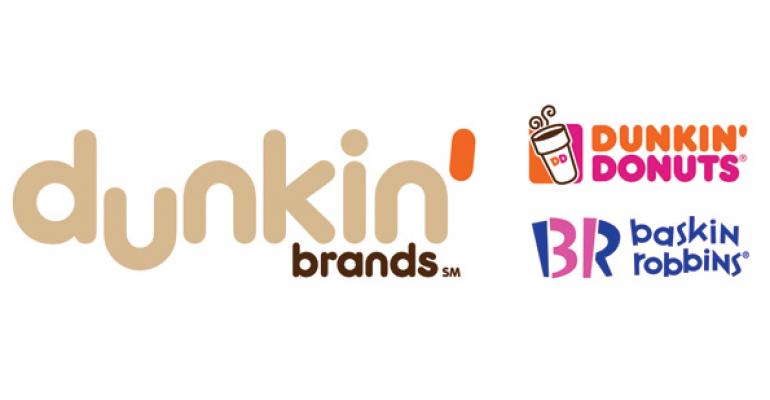Dunkin’ Brands Group Inc.’s hopes for a rebound in the second quarter didn’t materialize, leading the company to lower expectations Thursday for the year.
After a first quarter dampened by severe winter weather in the U.S., Dunkin’ officials expected the second quarter ended June 28 to show significant improvement and get the company back on track to meet full-year projections.
Instead, lingering macroeconomic challenges and cold spring weather held back sales, and the company pulled back on targets for the full year.
RELATED
• Dunkin’ Brands 4Q profit rises 23%
• Domestic growth helps drive 3Q traffic, sales at Dunkin'
• More restaurant finance news
Rather than the 3 percent to 4 percent same-store sales increase expected for Dunkin’ Donuts in the U.S., the company now expects same-store sales growth of between 2 percent to 3 percent. Expectations that same-store sales will increase between 1 percent and 3 percent for Baskin-Robbins in the U.S. remain unchanged.
“Our performance in the second quarter was disappointing, both domestically and internationally,” said Nigel Travis, Dunkin’ Brands’ chairman and chief executive.
“It was a tough quarter for both the QSR industry and for the retail sector, which the numbers being reported by other companies are supporting,” Travis said. “The consumer, particularly at the low end, is in a tough spot.”
Travis blamed a number of macroeconomic challenges, including job growth failing to improve, a reduction in government programs, lackluster Gross Domestic Product growth, and even the residual expense from increased heating costs.
In addition, the competitive landscape at breakfast has also become more difficult for Dunkin’ Donuts, but not because of newcomers to the space, Travis said, likely referring to Taco Bell.
Rather, discounting by competitors like McDonald’s has challenged Dunkin’ Donuts, which responded with its own free coffee offers that nipped into the chain’s average check. Sales of breakfast sandwiches have remained strong.
Still, Dunkin’s discounting had positive results. Travis said transactions rose and discounts drove new beverage trial.
Overall results in the U.S. showed other positives.
Same-store sales for Dunkin’ Donuts in the U.S. rose 1.8 percent, with about half of the increase coming from traffic.
Travis said the doughnut chain had the highest guest counts on record during afternoon hours, in part because of promotions in some markets to entice guests into locations later in the day.
The company said close to 8 million customers have downloaded the Dunkin’ Donuts mobile app. The company’s new DD Perks loyalty program has reached 1.3 million members.
Baskin-Robbins recorded a 4.2-percent same-store sales increase, benefiting from online cake ordering and a new program offering guests a free waffle cone with the purchase of a second scoop of ice cream.
Internationally, however, Dunkin’ Donuts’ same-store sales fell 3.1 percent, largely on poor results in South Korea. For Baskin-Robbins International, the 1.6-percent decrease in same-store sales was largely blamed on weak sales in Japan.
Overall, for the second quarter, the Canton, Mass.-based company reported net income of $46.2 million, or 43 cents per share, a 13.2-percent increase from $40.8 million, or 38 cents per share.
Revenue rose 8.4 percent, to $190.9 million, compared with $182.5 million a year ago.
For the year, however, Dunkin’ Brands now expects revenue growth of between 5 percent and 7 percent, compared with earlier projections of 6 percent to 8 percent.
The company also lowered its earnings per share target for the year to between $1.73 and $1.77, falling from an earlier forecast of between $1.79 and $1.83.
Dunkin’ Brands ended the quarter with 11,000 Dunkin’ Donuts units and 7,300 Baskin-Robbins locations around the world. Both brands are nearly 100-percent franchised.
Contact Lisa Jennings at [email protected].
Follow her on Twitter: @livetodineout





